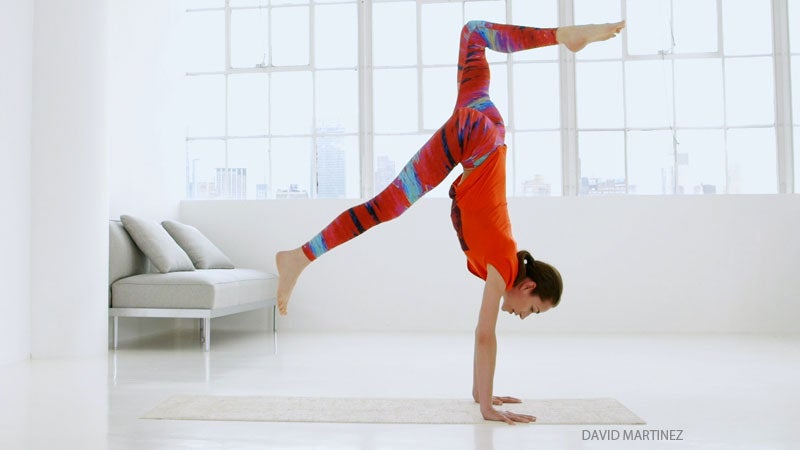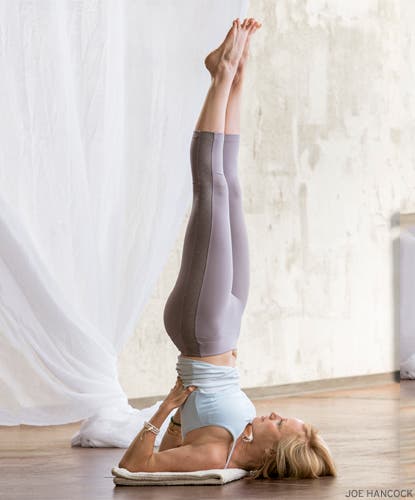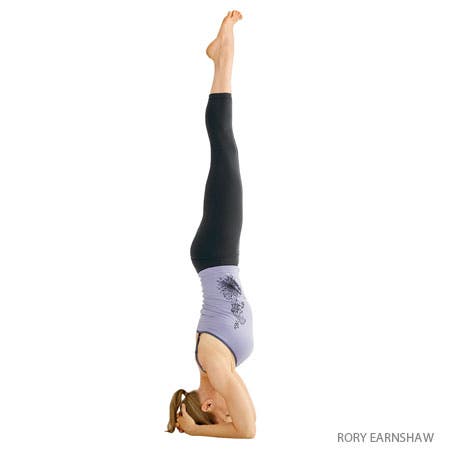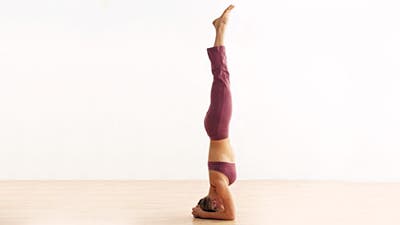Do You Have a Royal Fear of Inversions?

A Beginner’s Guide to Yoga’s Key Inversions: Learn how to face your fear of going upside down and why it’s so worth doing.
When I announced that it was time for Sirsasana (Headstand) during a workshop I was teaching in Philadelphia a few years ago, an elderly woman slunk out of the room, quickly followed by her yoga teacher. Moments later, they both came back. Later, I learned that the student had left the room because she had never been upside down in her life and was frightened to try; her yoga teacher had gently persuaded her to return, telling her that this was the perfect opportunity. Hesitantly, the student had agreed.
I helped her up, kept her there for about 15 seconds, and carefully brought her down. She stood up, smiled, and gave me a big hug. The next day, the first thing she said to me was, “Can you take me upside down again today?” I’ve been told that she has been up during every single class since. At a spry 82, this woman had faced her fears, empowered herself, and made herself more able in old age than in youth.
Since we rarely, if ever, purposefully turn ourselves upside down, an aversion to inversions is natural. But it’s a shame to let fear keep us from so many benefits and delights. Ralph Waldo Emerson once wrote, “He has not learned the lessons of life who does not every day surmount a fear.”

Why Inversions Are Key to the Practice of Yoga
A yoga practice without inversions is like a marriage without a spouse, lemonade without lemons, or a body without a heart—the essence is missing. Inversions set yoga apart from other physical disciplines: Psychologically, they allow us to see things from an alternate perspective. Emotionally, they guide the energy of the pelvis (the energy of creation and personal power) toward the heart center, enabling self-exploration and inner growth. Physically, they stimulate the immune and endocrine systems, thereby invigorating and nourishing the brain and the organs. When done correctly, inversions also release tension in the neck and the spine.
Because of their myriad benefits, Sirsasana (Headstand, pronounced shir-SHA-sa-nuh) and Sarvangasana (Shoulderstand, pronounced sar-vaan-GAH-sa-nuh) are considered to be the king and queen of asanas, respectively. Sirsasana develops our capacity for action (fire element) and enhances our ability to create (air element). Sarvangasana nurtures our capacity to stop doing and get grounded (earth element) and fosters our ability to be still and reflect (water element). Sirsasana makes us more alert and focused, while Sarvangasana makes us calm and receptive.
To receive these palpable benefits—and to prevent injury, especially to the neck—it’s essential to learn the correct setup and alignment for each pose. Also, I recommend that women forgo inversions during their menstrual period; reversing blood flow goes against the body’s natural urge to release stale blood and the endometrial lining, and it may lead to a backflow of menstrual fluid (known as retrograde menstruation). Other contraindications include neck injuries, epilepsy, high blood pressure, heart conditions, and eye problems. So be mindful about your body as you approach these poses, but give them a try.
After 36 years of yoga, I practice both poses every day and recommend the same to my students. It takes a while to build up a practice of Sarvangasana and Sirsasana, however. Be patient with yourself and take the time to master them; if you do, you will reap their benefits for the rest of your life.

Learning Shoulderstand
A healthy sarvangasana requires a strong opening of the armpits and a rolling of the shoulders back and toward each other to allow the neck to release properly.
How to Prepare for Shoulderstand
A good way to prepare for this is to stand with your back near a table, interlock your fingers, place your hands on the table, and bend your knees while lifting your chest. This replicates the movement necessary in the full pose but places no weight on the head or neck, allowing you to cultivate flexibility without risk.
Setu Bandha Sarvangasana (Bridge Pose) is another good preparation, because it distributes weight between the feet and upper body while protecting the neck.
Are You Ready for Sarvangasana?
While in Bridge Pose, you can check to see if you’ve developed the necessary flexibility in your shoulders for Sarvangasana: Lift your pelvis, leave your shoulders on the floor, and notice your seventh cervical vertebra (C7), that big bump at the bottom of the neck. If it’s pressing into the floor, you are not yet ready for the next step, or you will need firm blankets or foam pads to support your body. If you use blankets or pads, they should support your body from your elbows to your shoulders and upper trapezius muscles, which cover the upper-back part of the neck and shoulders. If you have stiff trapezius muscles, C7 will also rest on the pads. Eventually, your chest will touch your chin, indicating that your neck is mobile enough for you to practice Sarvangasana.
Where to Start
If you feel you are ready to move on, try Ardha Sarvangasana (Half Shoulderstand). This is done with the pelvis lifted off the floor, the feet on the wall, and the shoulders rolled under with two or three carefully folded blankets or firm pads under them to ensure that the neck is pain-free. The pads should be in the same position as described above for Setu Bandha Sarvangasana. In time, you will feel ready to do full Sarvangasana by lifting one leg at a time from Ardha Sarvangasana.
Props
While pads are unnecessary for perfect bodies, for the rest of us, they are necessary. Ultimately, the shoulders themselves become the pads and no part of the spine touches the floor. In the meantime, the stiffer the shoulders, the higher the pads need to be. Though many instructors teach this pose without pads, I value my students’ necks and consider pads to be an indispensable part of the posture.
The Effects of Shoulderstand
After you come out of Sarvangasana, sit up and notice its effects. Your eyelids should feel heavy and your facial muscles soft and weighted, as if your jawbone is going to drop off. If you feel agitated, angry, or tense, you may have stayed in the pose too long or may need assistance with your alignment; in that case, consult a trained teacher.

Learning Headstand
The gifts of Sirsasana are so great that even if you are not ready to do the actual pose, you can benefit by preparing for it. The preparations help you strengthen the latissimus dorsi muscles—the large muscles that attach the upper arms to the back—as well as help create the awareness required to spread, lift, and strengthen the muscles around the shoulder blades so that the neck is protected.
How to Prepare for Sirsasana
Start in Adho Mukha Svanasana (Downward-Facing Dog Pose) and focus on engaging the muscles that spread the shoulder blades away from each other, away from the floor, and toward the rib cage. This action will build the upper-body strength you will need, and when you re-create this in Sirsasana, both your head and neck will be protected. In Adho Mukha Svanasana, make sure that your shoulder blades are wide and your neck is long. (You can allow your head to rest on a block.)
Are You Ready for Headstand?
In Downward-Facing Dog, check to see if your shoulders are below an imaginary line drawn between your wrists and buttocks—if so, you are ready to go on.
Setting Up
Learning how to set up your arms and head is the next step toward Sirsasana. Interlock your fingers and thumbs on the floor in front of you. Keep your wrists as far apart as possible and your elbows shoulder width apart, so that your inner elbows and inner armpits form a square. Place your head against your wrists and thumb mounds; your head should rest on the floor at your fontanel (the spot in front of the crown of the head) or slightly in front of it. You can find the fontanel by feeling for the big bump on the top of your head and then sliding your fingers forward; you will feel a valley (the fontanel) followed by a second bump. Then come out of the setup.
Props
If you have stiff shoulders and a rounded upper back, try a Sirsasana preparation with firm pads against a wall. This helps flatten and open your upper back, create a soft neck, and encourage the sense of lift in your shoulders that is necessary for doing Sirsasana correctly. Set up your head and arms with your knuckles touching the wall, then walk your feet toward your arms and straighten your legs. Press your wrists down and try to take your shoulders off the pads; as you do so, you should feel your head lifting off the floor.
Where to Start
As a beginning yoga student, you should have 90 percent of your weight on your forearms and 10 percent on your head in Sirsasana. As you evolve in the posture, you’ll put more weight on your head until eventually almost 100 percent of your weight is on your head. Many beginners find that Sirsasana is no longer scary when they realize there is very little weight on their head and neck.
The next step is Ardha Sirsasana (Half Headstand). There are no balance issues in this preparatory pose, because the arms are on the floor and the feet are pressing against the wall with the legs parallel to the floor. Start by kneeling with your back toward a wall, and place your arms on a sticky mat set a leg’s length from the wall. To set up the pose, interlock your fingers and thumbs, place your elbows shoulder width apart, bring your fontanel to the floor, and make sure that your head is not tipped or twisted to one side. Lift your shoulders, moving your shoulder blades up and apart like water flowing from a fountain. Then slowly walk your feet up the wall until your thighs and legs are parallel to the floor. Hold the pose for about half a minute—being very aware of your shoulder blades lifting and expanding—and then come down. If your shoulder blades moved up and away from each other in the pose, you are ready for Sirsasana.
How to Come Into Headstand
To move into the full pose, set your sticky mat next to a wall and place your knuckles next to the wall. To come up, follow the setup instructions for the head and shoulders; then, with your legs bent, gently jump both legs up and land with the soles of your feet touching the wall. Straighten your legs one at a time, pressing them together.
The Effects of Sirsasana
When you come out of Sirsasana and sit up, you should feel a peaceful, focused sensation in your brain and nerves. Your hands should be calm and steady. If they are not, you have stayed too long, worked incorrectly, or worked too hard. Never strain in this pose. Have your teacher check your pose frequently to see that your head and neck are in the correct alignment and that your shoulders are lifting and widening properly.

Sequencing Your Inversions
Now that you know how to do Sirsasana and Sarvangasana, how do you fit them into your practice sequence? Shoulderstand should be done after Headstand (although you don’t have to do it immediately after), because Sirsasana warms the body up and Sarvangasana cools the body down. Additionally, in Sarvangasana, the back of the neck is released and the vertebrae are extended, releasing any tension and compression in the neck that an incorrect Sirsasana may have caused. In a well-rounded practice session, Sirsasana should come after standing poses and before other intense work such as backbends and deep twists. Sarvangasana follows, and then Savasana (Corpse Pose). If you have neck issues, it is better to do Sarvangasana before mild backbends, because backbends can relieve any tension in the neck caused by Sarvangasana.
How long should you hold the poses? The rule of thumb is to hold Sarvangasana twice as long as Sirsasana yet never to the point of strain. I highly recommend working on these poses in class with a knowledgeable teacher for a few months before doing them at home, although it is wise to keep practicing the preparations on your own. A well-trained, experienced, and attentive teacher can help you determine when you are ready to practice them alone.
I hope these words have encouraged you to begin a lifelong practice of these magnificent poses in a way that is both safe and beneficial. In doing these two inversions, the king and queen of asanas, you will be experiencing the essence of yoga. May your work help you discover the fragrant sweetness that is, after all, your own inner essence.